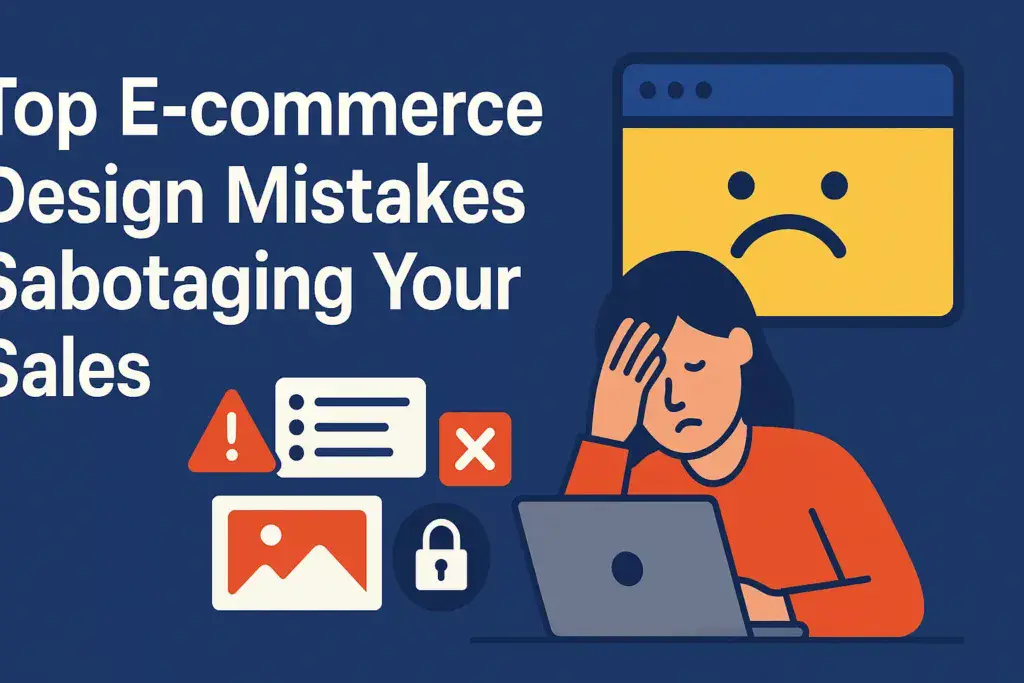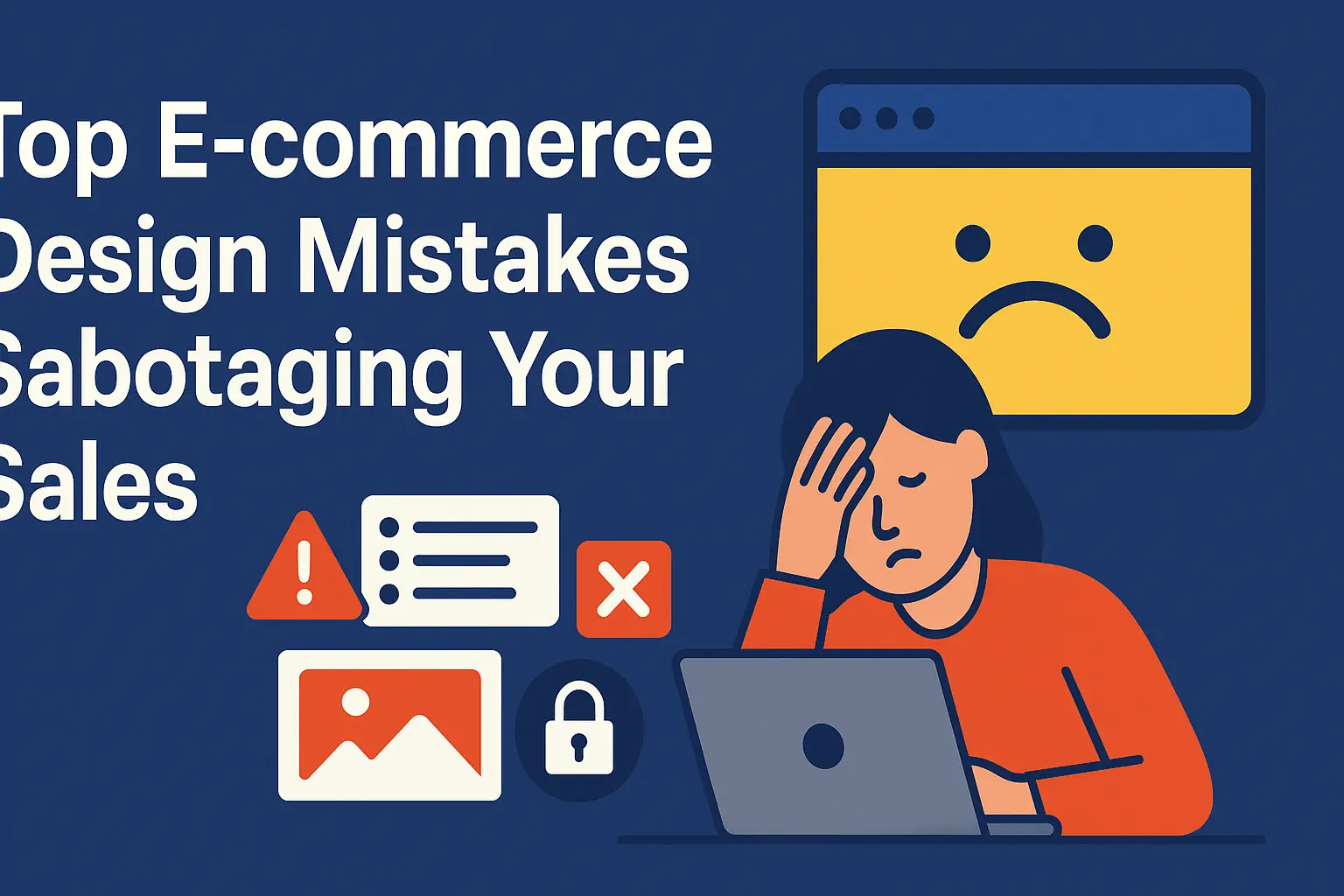
I. Introduction to E-commerce Design Mistakes
In the rapidly evolving digital marketplace, the design of an e-commerce website plays a pivotal role in determining its success. As onlineTop E-commerce Design Mistakes Sabotaging Your Sales: A Guide to Enhancing User Experience and Trust shopping becomes increasingly prevalent, businesses must recognize that a well-designed site is more than just aesthetically pleasing; it is a critical tool for enhancing customer engagement and driving sales. However, many online retailers fall prey to common design mistakes that can significantly hinder their performance and revenue potential.
From complicated navigation structures that frustrate users to poor visual choices that undermine brand identity, these pitfalls can create barriers that prevent potential customers from completing their purchases. Additionally, neglecting crucial trust signals, such as customer reviews and secure payment options, can lead to lost sales and diminished consumer confidence.
In this article, we will explore the most prevalent e-commerce design mistakes that can hurt sales performance. By understanding these missteps, online retailers can take actionable steps to optimize their websites, enhance user experience, and ultimately improve their bottom line. Whether you are a seasoned e-commerce professional or just starting out, recognizing and addressing these design flaws is essential for achieving long-term success in the competitive online landscape.
II. Neglecting User Experience (UX)
User experience (UX) plays a pivotal role in the success of any e-commerce website. When consumers visit an online store, they expect a seamless and intuitive experience that allows them to find what they need quickly and efficiently. Neglecting UX can lead to frustration and ultimately drive potential customers away. Below are some of the most common pitfalls related to user experience that can hinder sales performance.
A. Complicated Navigation Structures
One of the primary aspects of UX is navigation. A complicated navigation structure can confuse users, making it difficult for them to locate products or information. If customers struggle to find what they are looking for, they are more likely to abandon their shopping cart and leave the site. To avoid this mistake, e-commerce sites should prioritize clear, logical navigation paths. This includes using well-defined categories, incorporating a search bar, and ensuring that links are easily accessible. A straightforward navigation system not only enhances the customer experience but also encourages users to explore more products, ultimately increasing the chances of conversion.
B. Lack of Mobile Responsiveness
With the increasing prevalence of mobile commerce, having a mobile-responsive design is no longer optional; it is essential. A significant number of users browse and shop using their smartphones and tablets. If an e-commerce site does not adapt well to different screen sizes, it can result in a frustrating experience characterized by distorted images, unreadable text, and buttons that are difficult to click. This can lead to higher bounce rates and lost sales opportunities. To ensure a positive mobile experience, e-commerce retailers should implement responsive design practices, testing their sites across various devices to guarantee that customers enjoy a consistent and user-friendly experience, regardless of how they access the site.
C. Overwhelming Pop-ups and Ads
While pop-ups and advertisements can be effective marketing tools, excessive use can detract from the user experience. Overwhelming visitors with multiple pop-ups, especially those that appear immediately upon entering a site, can create a sense of chaos and irritation. Instead of engaging customers, these interruptions often lead to frustration and prompt users to leave. To maintain a positive UX, e-commerce websites should use pop-ups sparingly and ensure they provide value, such as exclusive discounts or important announcements. Timing is also crucial; pop-ups should appear at strategic moments, such as when a user is about to leave the site, rather than as soon as they arrive. By striking the right balance, e-commerce retailers can enhance user experience while still achieving their marketing goals.
In conclusion, neglecting user experience can significantly impact an e-commerce site’s sales performance. By addressing navigation complexity, ensuring mobile responsiveness, and managing pop-ups effectively, retailers can create a more enjoyable shopping experience that keeps customers coming back.
III. Poor Visual Design Choices
Visual design plays a pivotal role in shaping customer perceptions and influencing purchasing decisions in the realm of e-commerce. When online stores overlook essential visual design principles, they risk not only alienating potential buyers but also undermining their own brand identity. Below, we explore some of the most common visual design mistakes that can detract from the shopping experience and ultimately hurt sales performance.
A. Inconsistent Branding Elements
Brand consistency is crucial for establishing trust and recognition among consumers. When an e-commerce site fails to maintain uniformity in its branding elements—such as logos, colors, fonts, and imagery—it creates confusion and diminishes the perceived credibility of the brand. For instance, if a website uses different fonts or color palettes across various pages, visitors may struggle to identify the brand, leading to a fragmented experience. This inconsistency not only disrupts the visual flow but can also make customers feel uncertain about the brand’s professionalism. To foster a cohesive identity, businesses should ensure that all branding elements align with their core values and messaging, creating a seamless visual journey for customers.
B. Low-quality Images and Graphics
In the digital marketplace, high-quality visuals act as vital selling tools. When e-commerce sites utilize low-quality images or poorly designed graphics, they risk damaging their brand’s reputation and discouraging potential buyers. Customers are less likely to trust a product that is showcased with blurry or pixelated images, as this can imply a lack of attention to detail and professionalism. Moreover, low-quality visuals can lead to misunderstandings about the product, resulting in higher return rates and customer dissatisfaction. To enhance the shopping experience, businesses should invest in high-resolution images and professional graphics that accurately represent their products, allowing customers to visualize the item as they would in a physical store.
C. Confusing Color Schemes
Color is a powerful tool in e-commerce design, influencing emotions and behaviors. However, a confusing or overly complex color scheme can detract from the user experience. When colors clash or are used excessively, it can create visual chaos, making it difficult for customers to navigate the site or focus on key elements. For instance, if a website employs a rainbow of colors without a clear hierarchy, visitors may find it challenging to discern where to click or what to prioritize. Effective color schemes should enhance readability and guide users toward important calls to action. By using a limited palette that aligns with the brand’s identity, businesses can create a visually appealing and easy-to-navigate site that engages customers and drives conversions.
Embrace color psychology in ecommerce to select tones that emotionally resonate with your customers and drive conversions.
In conclusion, poor visual design choices can significantly impact an e-commerce site’s effectiveness. To ensure a positive user experience and bolster sales performance, businesses must prioritize consistent branding, high-quality visuals, and thoughtful color schemes. By addressing these design elements, e-commerce sites can foster a more inviting atmosphere, ultimately leading to increased customer trust and higher conversion rates.
IV. Ignoring Trust Signals
In the realm of e-commerce, trust is a critical currency. When potential customers visit an online store, they need to feel confident that their personal information is secure and that they are making a sound purchasing decision. Ignoring trust signals can significantly hinder sales performance, as customers are less likely to complete a transaction if they have doubts about the reliability of the site. This section will explore three common pitfalls related to trust signals that can negatively impact an e-commerce business.
A. Lack of Customer Reviews and Ratings
Customer reviews and ratings serve as powerful trust signals that can influence purchasing decisions. When potential buyers see positive feedback from previous customers, they are more likely to feel assured about the quality of the product and the reliability of the seller. Conversely, a lack of reviews can raise red flags, making consumers question the credibility of the business. E-commerce platforms that do not prominently display customer feedback miss an opportunity to build trust and encourage sales. Including a section for customer reviews, along with options for users to leave ratings and feedback, can create a sense of community and transparency, ultimately boosting consumer confidence.
B. Absence of Secure Payment Options
In an age where data breaches and online fraud are prevalent, customers are increasingly cautious about sharing their financial information. An e-commerce site that does not offer secure payment options can deter potential buyers, as they may fear for the safety of their credit card details. It’s essential for online retailers to incorporate trusted payment gateways and display security badges prominently during the checkout process. This not only reassures customers that their transactions are secure but also signals that the business takes their safety seriously. Providing a variety of payment methods, including credit cards, digital wallets, and buy-now-pay-later options, can further enhance the sense of security and convenience for the shopper.
To build confidence and reduce cart abandonment, be sure to showcase trust signals on the checkout page such as HTTPS badges, payment logos, and testimonials.
C. Not Displaying Contact Information
>Transparency is key to building trust in e-commerce. When a business fails to provide clear and accessible contact information, it creates a barrier between the retailer and the customer. Shoppers may feel uneasy about making a purchase if they cannot easily find a way to reach customer service for inquiries or issues. Including multiple contact methods—such as phone numbers, email addresses, and live chat options—can reassure customers that assistance is readily available if needed. Additionally, showcasing a physical address can add an extra layer of legitimacy to the business. By making contact information easy to find, e-commerce sites can foster trust and improve the overall customer experience.
In conclusion, neglecting trust signals in e-commerce design can lead to lost sales and a damaged reputation. By actively addressing elements like customer reviews, secure payment options, and accessible contact information, online retailers can create a trustworthy environment that encourages consumers to complete their purchases confidently.
V. Conclusion: Importance of Effective E-commerce Design
In the competitive landscape of online retail, effective e-commerce design is not just an aesthetic consideration; it is a fundamental component that directly influences sales performance. The way a website is designed can significantly impact user experience, customer trust, and ultimately, conversion rates. As we have explored throughout this article, neglecting critical design elements can lead to a frustrating shopping experience that drives potential customers away.
By prioritizing user experience, e-commerce businesses can create a seamless navigation structure that allows users to find products easily, access information without hassle, and enjoy a visually appealing interface. Mobile responsiveness is also essential in today’s digital environment, as a growing number of consumers shop via their smartphones and tablets. Failing to optimize for mobile can result in lost sales opportunities and a diminished brand reputation.
Equally important is the visual design of the e-commerce site. Inconsistent branding, low-quality images, and confusing color schemes can undermine consumer confidence and create a disjointed shopping experience. High-quality visuals and a cohesive design not only enhance the aesthetic appeal but also convey professionalism and reliability, which are vital in fostering customer loyalty.
Moreover, incorporating trust signals such as customer reviews, secure payment options, and readily available contact information is crucial for establishing credibility. Consumers are more likely to complete a purchase when they feel secure and informed, which highlights the necessity of designing with transparency and trust in mind.
In conclusion, effective e-commerce design is crucial for driving sales performance and ensuring long-term success. By addressing common design mistakes and focusing on creating a user-friendly, visually appealing, and trustworthy online shopping environment, e-commerce businesses can significantly enhance their chances of achieving sales growth and building a loyal customer base. Investing in thoughtful design is not just a luxury; it is a strategic necessity that can set a brand apart in an increasingly crowded marketplace.



